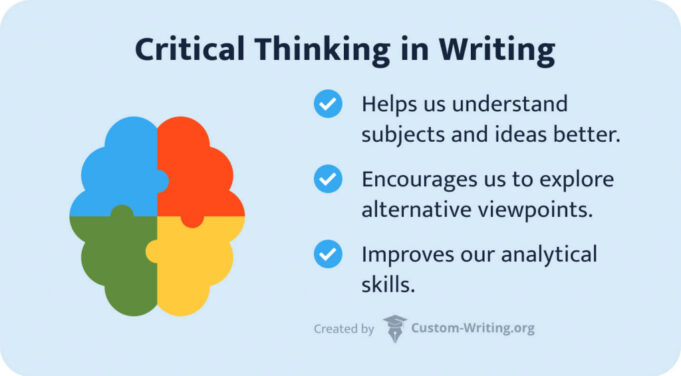Writing academic papers that are well-written and evidence-based is one way to improve your critical thinking. And keeping in mind that this task can be daunting, assessing information and giving justified conclusions can turn out to be less challenging with practice. In this article, we will provide an overview of what a critical thinking essay is, its outline, and the steps to write it.
Critical Thinking Essay – Meaning
As a type of writing, the purpose of critical thinking essays is to show that you can think critically about information and present reliable findings. Teachers use it to help students work with a lot of information and improve their analytical skills.
Writing assignments are one of the most practical ways to equip students with this skill. They learn that asking and responding to the right questions is the core of critical analysis essay writing. This type of writing is necessary for analyzing events, reflecting, and solving problems.
Reading texts carefully, applying a methodological approach, and identifying flaws and contradictions are the steps that lead to an excellent written piece. In addition, students must expound on different ideas, support, and construction information, and offer viewpoints. If you are struggling with your assignment, you may ask a professional to write my essay online.
How to Create an Outline for a Critical Thinking Essay
The outline acts as an organizer that makes your work put together and well structured. Below is the outline for the critical thinking essay.
Introduction
The opening section of your essay introduces the essay’s central idea. Here you must also emphasize the problem’s significance by including well-known facts. Last but not least, be sure to conclude the introduction with your thesis statement, which sets the stage for the subsequent explanations.
Main Part
Depending on how many assertions you want to discuss, the body can be broken up into several paragraphs. Consider using custom essay writing help for assisting you with framing your paper if you think you are struggling with the outline.
Utilize the body to create the outline supporting the main concerns. To accomplish this, you will need to rely on reliable research, examples, and citations. Counterarguments can also be included by writers to demonstrate their ability to confront opposing viewpoints and dismiss them as irrelevant. Counterarguments can also lend your piece credibility and objectivity.
Conclusion
The concluding section should evaluate cross-references, provide a summary of the arguments, and call for additional research. Additionally, the conclusion of the essay must include a logical summary of the findings by referring to the preceding points.
How to Write an Excellent Critical Thinking Essay
1. Explore the Subject
Investigate your mentor’s requirements and apply them in depth. Your instructor may also choose a topic for you (a book, film, piece of art, historical event, or social problem) or leave this up to you. Before you start researching and gathering information, make sure you understand the instructions. Reading materials that address the topic is also recommended.
2. Collect Data
Make relevant notes about the subject to aid in your writing. You can get information from primary sources, reviews from critics, and online materials. Preferably, you should gather no less than five references, like books, diaries, and articles. All of these must have a strong connection to your subject and support your argument.
3. Examine All Sides
Evaluate the evidence you find and address all sides of the issue. Make sure to state your position clearly and write a strong thesis statement. Any argument you choose to include in your final paper needs to be well-supported. Finally, make use of this step to demonstrate your imaginative side and offer novel approaches to the problem that no one else has considered.
4. Compose the Main Draft
Use interesting statistics and facts, ask a question, or share an anecdote to attract the reader’s interest. Avoid overgeneralized and cliched beginnings. Ensure that the reasoning backs up the main claim and supports your position when writing the essay. Conciseness is essential, and refrain from veering off course by adding unnecessary fillers and information, advises the eduhelphub expert.
The value of your discussion should also be evaluated in the body paragraphs. Remember, critical thinking abilities are required for conducting in-depth process analyses and selecting ideas that are both credible and controversial.
5. Revise and Edit
Once the initial draft is finished, sleep on it and proofread it the next day. Check to see if the argumentation and facts are consistent and accurate in the paper. Additionally, you must check your work for spelling and grammar errors. In addition, it is essential to seamlessly transition from one idea to another to convey your thoughts. Last but not least, check your work for signs of plagiarism and make sure you properly cited your sources Readmore







